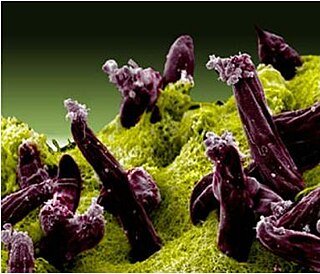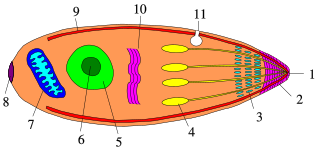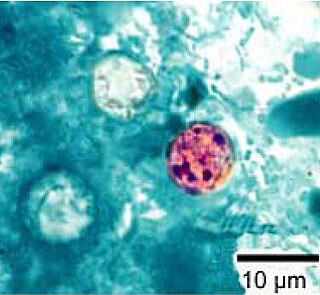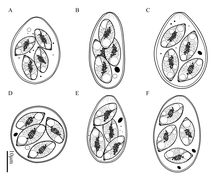
Toxoplasma gondii is a parasitic protozoan that causes toxoplasmosis. Found worldwide, T. gondii is capable of infecting virtually all warm-blooded animals, but felids are the only known definitive hosts in which the parasite may undergo sexual reproduction.

Coccidia (Coccidiasina) are a subclass of microscopic, spore-forming, single-celled obligate intracellular parasites belonging to the apicomplexan class Conoidasida. As obligate intracellular parasites, they must live and reproduce within an animal cell. Coccidian parasites infect the intestinal tracts of animals, and are the largest group of apicomplexan protozoa.

Plasmodium malariae is a parasitic protozoan that causes malaria in humans. It is one of several species of Plasmodium parasites that infect other organisms as pathogens, also including Plasmodium falciparum and Plasmodium vivax, responsible for most malarial infection. Found worldwide, it causes a so-called "benign malaria", not nearly as dangerous as that produced by P. falciparum or P. vivax. The signs include fevers that recur at approximately three-day intervals – a quartan fever or quartan malaria – longer than the two-day (tertian) intervals of the other malarial parasite.
Coccidiosis is a parasitic disease of the intestinal tract of animals caused by coccidian protozoa. The disease spreads from one animal to another by contact with infected feces or ingestion of infected tissue. Diarrhea, which may become bloody in severe cases, is the primary symptom. Most animals infected with coccidia are asymptomatic, but young or immunocompromised animals may suffer severe symptoms and death.

Eimeria tenella is a species of Eimeria that causes hemorrhagic cecal coccidiosis in young poultry. It is found worldwide.

Plasmodium gallinaceum is a species of the genus Plasmodium that causes malaria in poultry.

Sarcocystis is a genus of protozoan parasites, with many species infecting mammals, reptiles and birds. Its name is dervived from Greek sarx = flesh and kystis = bladder.
Eimeria stiedae is a species of Eimeria that causes hepatic coccidiosis in rabbits. It was observed for the first time by Antonie van Leeuwenhoek in 1674.

Leucocytozoon is a genus of parasitic alveolates belonging to the phylum Apicomplexa.

Apicomplexans, a group of intracellular parasites, have life cycle stages that allow them to survive the wide variety of environments they are exposed to during their complex life cycle. Each stage in the life cycle of an apicomplexan organism is typified by a cellular variety with a distinct morphology and biochemistry.
Acroeimeria is a genus of parasites that contains those species which initially develop immediately beneath the brush-border of the intestinal epithelium, but the meronts and gamonts of which are early on extruded to form a layer on the surface of the gut mucosa. Morphologically they are similar to the Eimeria to which they are closely related. The genus was described in 1989 by Paperna and Landsberg.

Cyclospora is a genus of apicomplexan parasites. It includes the species Cyclospora cayetanensis, the causative agent of cyclosporiasis. Members of Cyclospora are characterized as having oocysts with two sporocysts, each containing two sporozoites.
The genus Schellackia comprises obligate unicellular eukaryotic parasites within the phylum Apicomplexa, and infects numerous species of lizards and amphibians worldwide. Schellackia is transmitted via insect vectors, primarily mites and mosquitoes, which take up the parasite in blood meals. These vectors then subsequently infect reptilian and amphibian which consume the infected insects. The parasites deform erythrocytes of the host into crescents, and can be visualized using a blood smear.

Cystoisospora belli, previously known as Isospora belli, is a parasite that causes an intestinal disease known as cystoisosporiasis. This protozoan parasite is opportunistic in immune suppressed human hosts. It primarily exists in the epithelial cells of the small intestine, and develops in the cell cytoplasm. The distribution of this coccidian parasite is cosmopolitan, but is mainly found in tropical and subtropical areas of the world such as the Caribbean, Central and S. America, India, Africa, and S.E. Asia. In the U.S., it is usually associated with HIV infection and institutional living.
Hammondia hammondi is a species of obligate heteroxenous parasitic alveolates of domestic cats. Intracellular cysts develop mainly in striated muscle. After the ingestion of cysts by cats, a multiplicative cycle precedes the development of gametocytes in the epithelium of the small intestine. Oocyst shedding persists for 10 to 28 days followed by immunity. Cysts in skeletal muscle measure between 100 and 340 μm in length and 40 and 95 μm in width. Some of the intermediate hosts develop low levels of antibody and some cross-immunity against Toxoplasma.
Cystoisospora canis, previously known as Isospora canis, is a microscopic, coccidian parasite that causes an intestinal tract infection in dogs. The intestinal tract infection is coccidiosis caused by a protozoa called coccidia.

Plasmodium cynomolgi is an apicomplexan parasite that infects mosquitoes and Asian Old World monkeys. In recent years, a number of natural infections of humans have also been documented. This species has been used as a model for human Plasmodium vivax because Plasmodium cynomolgi shares the same life cycle and some important biological features with P. vivax.
Eimeria zuernii is a species of the parasite Eimeria that causes diarrheic disease known as eimeriosis in cattle, and mainly affects younger animals. The disease is also commonly referred to as coccidiosis. The parasite can be found in cattle around the globe.
Eimeria arlongi is a species of Eimeria that causes clinical coccidiosis in goats. It and Eimeria ninakohlyakimovae are two of the most pathogenic species for goats. It is particularly prevalent in goat kids in Iran. Issues with coccidiosis specifically due to Eimeria arloingi have also been reported in Egypt and Portugal. It is unclear whether this species is present in the Americas as most of the case reports of coccidiosis in these areas do not differentiate the species causing the disease. Infections with this species are commonly compounded by infections with other Eimeria species in "mixed infections." This species is closely related to Eimeria bovis and Eimeria zuernii which are both highly pathogenic in cattle' Infections with this species are characterized by lesions specifically in the jejunum, but also the ilium and cecum which results in diarrhea. Oocysts begin shedding between 16 and 18 days after the animal is infected which is when the parasite is spread. The shedding can last as long as 15 days. This parasite causes an immune response in its host that includes accumulation of fluid in body cavities, presence of large numbers of leukocytes in the small intestine, and necrosis of the tissue of the small intestine. Pale yellow plaques can be seen on the small intestine of severely affected kids at necropsy.
Eimeria bovis is a parasite belonging to the genus Eimeria and is found globally. The pathogen can cause a diarrheic disease in cattle referred to as either eimeriosis or coccidiosis. The infection predominantly cause disease in younger animals.














